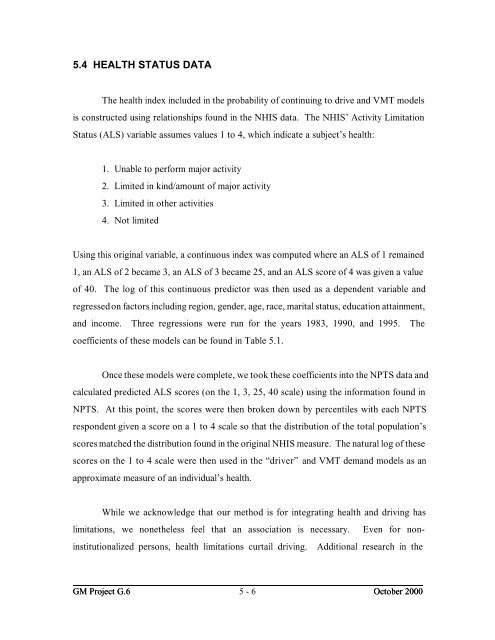Projecting Fatalities in Crashes Involving Older Drivers, 2000-2025
Projecting Fatalities in Crashes Involving Older Drivers, 2000-2025
Projecting Fatalities in Crashes Involving Older Drivers, 2000-2025
Create successful ePaper yourself
Turn your PDF publications into a flip-book with our unique Google optimized e-Paper software.
5.4 HEALTH STATUS DATA<br />
The health <strong>in</strong>dex <strong>in</strong>cluded <strong>in</strong> the probability of cont<strong>in</strong>u<strong>in</strong>g to drive and VMT models<br />
is constructed us<strong>in</strong>g relationships found <strong>in</strong> the NHIS data. The NHIS’ Activity Limitation<br />
Status (ALS) variable assumes values 1 to 4, which <strong>in</strong>dicate a subject’s health:<br />
1. Unable to perform major activity<br />
2. Limited <strong>in</strong> k<strong>in</strong>d/amount of major activity<br />
3. Limited <strong>in</strong> other activities<br />
4. Not limited<br />
Us<strong>in</strong>g this orig<strong>in</strong>al variable, a cont<strong>in</strong>uous <strong>in</strong>dex was computed where an ALS of 1 rema<strong>in</strong>ed<br />
1, an ALS of 2 became 3, an ALS of 3 became 25, and an ALS score of 4 was given a value<br />
of 40. The log of this cont<strong>in</strong>uous predictor was then used as a dependent variable and<br />
regressed on factors <strong>in</strong>clud<strong>in</strong>g region, gender, age, race, marital status, education atta<strong>in</strong>ment,<br />
and <strong>in</strong>come. Three regressions were run for the years 1983, 1990, and 1995. The<br />
coefficients of these models can be found <strong>in</strong> Table 5.1.<br />
Once these models were complete, we took these coefficients <strong>in</strong>to the NPTS data and<br />
calculated predicted ALS scores (on the 1, 3, 25, 40 scale) us<strong>in</strong>g the <strong>in</strong>formation found <strong>in</strong><br />
NPTS. At this po<strong>in</strong>t, the scores were then broken down by percentiles with each NPTS<br />
respondent given a score on a 1 to 4 scale so that the distribution of the total population’s<br />
scores matched the distribution found <strong>in</strong> the orig<strong>in</strong>al NHIS measure. The natural log of these<br />
scores on the 1 to 4 scale were then used <strong>in</strong> the “driver” and VMT demand models as an<br />
approximate measure of an <strong>in</strong>dividual’s health.<br />
While we acknowledge that our method is for <strong>in</strong>tegrat<strong>in</strong>g health and driv<strong>in</strong>g has<br />
limitations, we nonetheless feel that an association is necessary. Even for non-<br />
<strong>in</strong>stitutionalized persons, health limitations curtail driv<strong>in</strong>g. Additional research <strong>in</strong> the<br />
GM Project G.6 5 - 6<br />
October <strong>2000</strong>
















